Products: Then & Now

Comparing snowmobile products from 1969 to now
How far has snowmobiling come in 40 years? A look back at some products from 1969 may surprise you as to how far the sport has come — or, not!
We scoured our archives to find five products from 1969 that have modern day counterparts. In most respects the old products retain the value of their original concepts, but are vastly improved thanks to modern materials and production processes. Regardless of the product improvements, it may surprise you to learn that our snowmobiling ancestors shared similar concerns for snowmobiling performance, comfort and warmth. Here’s a look at how the sport has evolved from then to now.
Performance
THEN — The Hirth “Honker” made big news in the late 1960s. Offered in the United States via Wisconsin Motor Corporation in Milwaukee, which provided sales and service support, the Hirth Model 230R displaced 793cc from three cylinders. Nicknamed the “Honker” by snowmobile racers, the two-stroke, air-cooled engine made 70 horsepower at 6500 revs. Of course, racers managed to coax more power from it.
Weighing in at 105 pounds, the Hirth motor featured aluminum cylinders with hard-chrome plating to optimize heat transfer. While performance engines of this era were air-cooled, many used auxiliary fan cooling. To reduce weight the Hirth relied on free air flowing over exposed cylinders as the snowmobile moved. Most racing sleds of the period featured low hoods that funneled cold air over the exposed engines. This usually meant a larger fin area on the engine cylinders, which culminated in a wild array of fins like the “sunburst” pattern seen in later years atop Kohler’s free-air racing motors. The 1969 Hirth powered racing sleds as well as some touring machines.
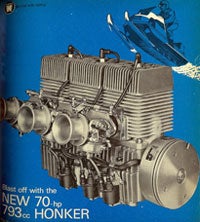 Hirth’s “big bore” 793cc Honker made 70 hp at 6500rpm.
Hirth’s “big bore” 793cc Honker made 70 hp at 6500rpm.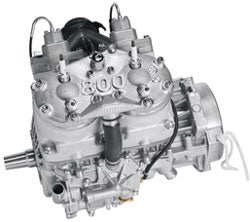 Arctic Cat’s latest 800cc twin makes 160-plus horsepower.
Arctic Cat’s latest 800cc twin makes 160-plus horsepower.NOW — Arctic Cat introduced a heavily revised 800cc twin to power its performance and deep powder models this past spring. Like the 1969 Hirth Honker, Arctic Cat’s new Suzuki-built engine displaces just under 800cc. Measuring 794cc from a bore and stroke of 85mm by 70mm, the new motor delivers more than double the power of that 40-years ago big-bore honker. And the Cat 800 does it with one less cylinder.
Of course, times have changed substantially in the technological arena. Where the Hirth sucked fuel via three diaphragm carburetors, the latest Arctic Cat design relies on batteryless electronic fuel injection, which virtually eliminates the throttle hesitation you’d get from the 40-year-old Hirth. With computer-controlled electronics the Cat engine compensates for barometric pressures automatically, meaning you don’t have to “dial” in carburetors as temperature or altitude change. Then, too, the modern day Cat engine responds to a power valve equipped tuned exhaust system. To keep performance consistent, today’s engines are liquid-cooled, meaning internal tolerances can be tighter and the engines run quieter.
If you look at performance differences, consider that the Hirth delivered about 90 hp per liter of displacement while the new Cat engine delivers closer to 200 hp per liter!
Snow Wear
THEN — Our snowmobiling forebears shared our concern for staying warm on snowmobiling treks. But in 1969 their styling choices were limited, although this period one-piece Thermorama suit was rated to -80 below zero. Of course, if you check out the felt-lined boots pictured in the advertisement, they appear similar to ones you’ll find today at Wal-Mart among other places.
Indeed, some of yesterday’s winter suits seem to have survived to one degree or another as staples for ice-fishing enthusiasts. You can still find premium Walls Blizzard-Pruf outer wear and other cold weather gear at various winter sports outfitters.
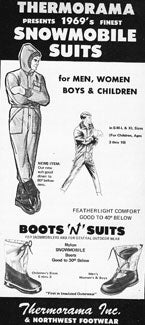 This Thermorama one-piece suit offered over style.
This Thermorama one-piece suit offered over style.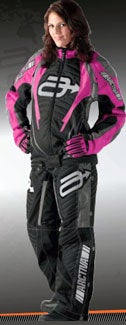 Modern wind and water proofing materials provide warmth and style.
Modern wind and water proofing materials provide warmth and style.NOW — Four decades of development in cold weather gear make a big difference to modern snowmobiling men and women. There have been big advances in wind and water resistant materials, meaning that today’s snowmobile wear fits better, looks better and works better than the best of the best from 1969. Check out the latest women’s apparel from Arctiva, which offers a specially patterned fit and the latest high-tech materials. The Women’s Comp 4 outfit features Hollofil insulation and taped seams combined with a waterproof, windproof, and breathable nylon construction. Apparel makers like KLIM take advantage of 3M’s Thinsulate material, which offers the advantages of down-like warmth with minimal bulk. You’ll also find materials like Gore’s Gore-Tex and Wind-Stopper used in the best snow wear. Gore-Tex allows internal body perspiration to escape while keeping the outer fabric waterproof. Wind-Stopper blocks cold wind from getting in but lets the snow garment breath to keep you comfortable. And, let’s not forget the tighter wind-sealing zippers and all-around functionality of Velcro used to seal wrist and pants leg areas. We’ll readily take today’s snow wear over what was available in 1969!
Tow Sleighs
THEN — Almost every major snowmobile manufacturer offered some kind of tow-along cutter or sleigh. They were usually of fiberglass construction, mounted on a set of leafspring skis and fixed with a simple tow hitch. Many were decorated to match the manufacturer’s basic models and even came with a fixed windshield. Designed to accommodate a couple of kids, the idea was to get the entire family out to enjoy winter activities. The Sno-Cruiser pictured was fairly typical of sleighs available in 1969.
Manufactured by General Aluminum Products in Charlotte, Mich., the Sno-Cruiser boasted almost “…five square feet of ski runner area (that) adds extra stability for fast runs.” Made of fiberglass the body was rubber mounted to a steel frame. To add sales appeal, the sleigh was available in color combinations to match virtually any sled brand. For onboard comfort the passengers — either two adults or three kids — sat on removable, vinyl-covered air-foam seat cushions.
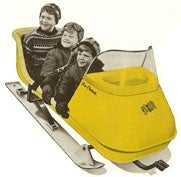 Early tow-behind sleighs featured leafsprung skis and room for three kids.
Early tow-behind sleighs featured leafsprung skis and room for three kids.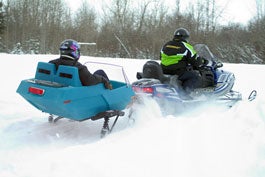 Boggans offers a variety of shock-equipped tow-along sleighs. (Image courtesy of Boggans)
Boggans offers a variety of shock-equipped tow-along sleighs. (Image courtesy of Boggans)NOW — Technology improvements since 1969 include the use of high-impact polyethylene construction, the addition of high performance gas shock absorbers, slick composite skis and full enclosure. Boggans by Equinox offers a wide variety of snowmobile sleigh options ranging from tow-behinds with a forward-opening door and rear storage trunk to open designs with high back type seating and windshield.
Boggans come with body reflectors as well as standard brake and running lights so the tow-along can be seen through snow dust and at night. Available in a variety of models for passenger or cargo, you can check them out online at Eqnx.biz/Boggans.
Ride Comfort
THEN — Back in the day, 40 years ago, snowmobilers looked for seating options. Sound familiar? In 1969 Laker Engineering of Alexandria, Minn., offered a “booster” seat filled with a combination of foam rubber and cotton. Covered in Naugahyde, a vinyl-coated fabric made to resemble leather, the optional “Jockey Seat” would fit most snowmobiles as the seat attached via metal snaps, which you would install. The device added extra comfort to the nominal foam filling prevalent in most sled seats of the period. The manufacturer suggested the booster option was especially useful for cross-country cruises. The seat sold for a mere US$17.95 — that would be approximately US$105 today.
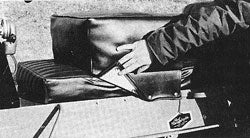 Early snowmobilers could add a Naugahyde-covered “booster” seat to enhance ride comfort.
Early snowmobilers could add a Naugahyde-covered “booster” seat to enhance ride comfort.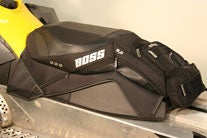 Modern snowmobilers can add storage and maximize their ride with BOSS specialty seats. (Image courtesy of BOSS Seats.)
Modern snowmobilers can add storage and maximize their ride with BOSS specialty seats. (Image courtesy of BOSS Seats.)NOW — Like our snowmobiling predecessors, we too are not always satisfied with our stock seats. That’s where companies like BOSS come in. Unlike our forebears, we are more demanding. You can find BOSS seats to fit most popular snowmobile models, especially the powder versions. Still, even flatlanders can upgrade their trail performance seats and opt in for a model like ones designed expressly for the Ski-Doo XP. Retailing for about US$400 (check with a dealer for current pricing), the BOSS Ski-Doo XP seat matches factory fit and finish but adds two pouches specifically for water bottles and a dozen separate storage areas. BOSS seats like the XP version retain the original equipment design’s height, but are much lighter and more comfortable. To find a local dealer or check out BOSS seat models, visit bossseats.com.
Hand Comfort
THEN — We’ll admit that some good ideas from 40 years ago survived. Before the advent of handlebar and thumb warmers, there was the handlebar mitt. These 1969 “muffs for buffs” fit over the ends of the sled’s handlebar, allowing you to still operate the throttle and brake controls, but providing very good wind protection. Made of French glove leather and lined with either cloth or sheepskin, the mitts sold for about US$18 per pair.
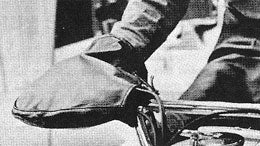 Before the advent of handlebar warmers, 1969 snowmobilers opted for handlebar mitts.
Before the advent of handlebar warmers, 1969 snowmobilers opted for handlebar mitts.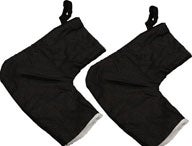 Handlebar mitts survived into the modern era but now are popular with ATVers and motorcyclists as well as snowmobilers.
Handlebar mitts survived into the modern era but now are popular with ATVers and motorcyclists as well as snowmobilers.NOW — The snowmobile handlebar mitt not only survived into 2009, but also now is available to fit ATVs as well as motorcycles. Interestingly, while there are facsimile models of handlebar mitts, there is one long time brand still around since snowmobiling’s early days. Hippo Hands, located in St. Catherines, Ont., are constructed of a wind and water-repelling heavyweight polyurethane nylon over a polyester fleece interior. To help the Hippo Hands retain their shape and allow easier insertion of your hands and arms, the manufacturer uses a plastic stiffener between the layers. The genuine Hippo Hands version of handlebar mitts retail for US$59.95 and up. You’ll want to specify your sled model, so check out HippoHands.com for specific pricing and sizing information.
Of course, if you search the Internet, you will find other handlebar mitt options that can be used on sleds, ATVs or motorbikes. From experience, we caution that not all sizes will fit both sleds and ATVs, so check out what mitts will fit your specific sled or ATV.
THEN & NOW — So, you thought only modern era snowmobilers had the answers to what makes a great riding experience? Sorry kids, those old-timers had similar concerns and found some interesting solutions for their needs. But, as snowmobilers of any age, we share a bond as we enjoy the fruits of each other’s efforts, some of which resulted in miles of trails, more reliable sleds, warmer apparel and always-clever products.





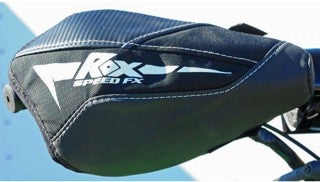


 Your Privacy Choices
Your Privacy Choices